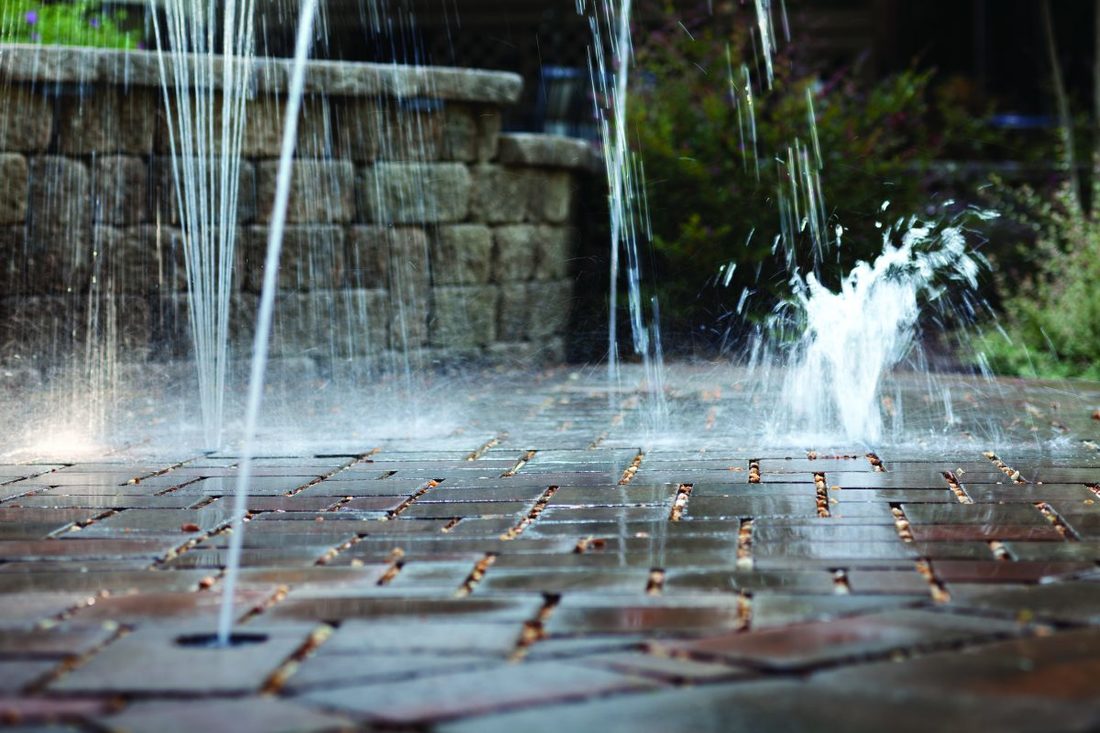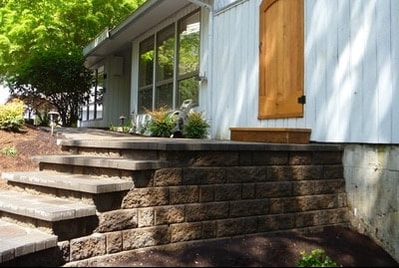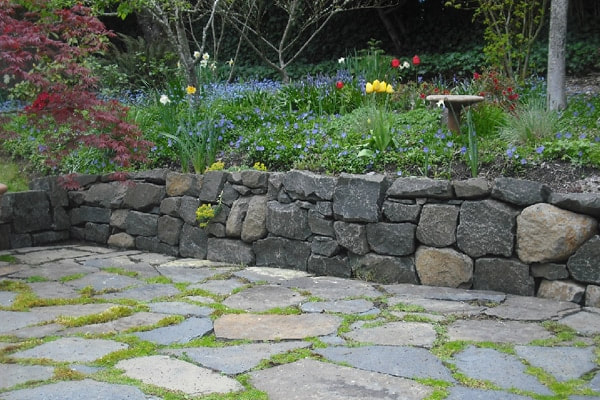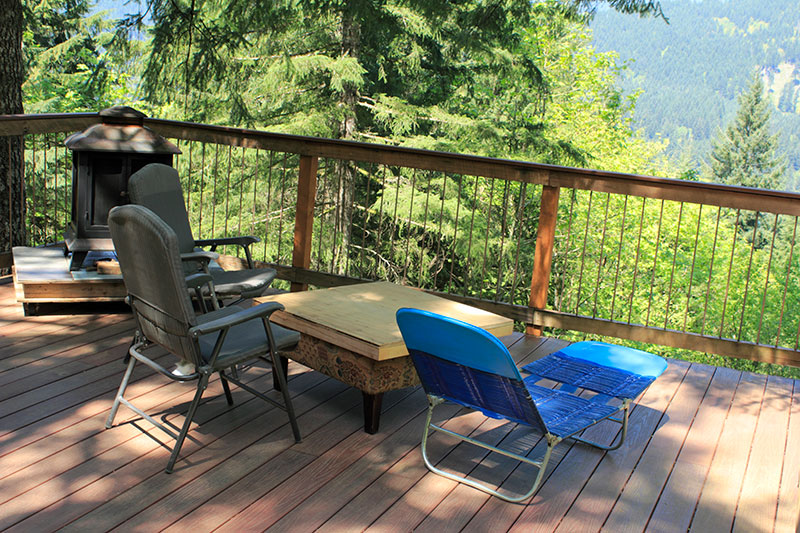|
If you're looking to add a hardscape to your backyard, one of the common materials used are pavers. Pavers come in all kinds of colors and can be paired nicely with other materials to create one-of-a-kind designs. However, most people are not familiar that there are different kinds of paver systems with permeable pavers being the more environmentally friendly choice.
Traditional pavers are laid over layers of stone and polymeric sand and feature tight joints so that when compacted, the pavers are set together. If stone dust or limestone screenings are used, there is a higher likelihood of trapping water and causing early failure of your pavers. Permeable pavers, on the other hand, are laid on multiple layers of crushed stone, and the joints between each paver are filled with smaller aggregate. This design allows water to instantly drain through the joints and percolate through the layers of aggregate below, where any impurities are trapped before water seeps into the ground and returns to local waterways. To create the ultimate sustainable patio, driveway or walkway, a permeable paver system can be designed to collect and recycle rainwater for irrigation and other purposes. And, depending on where your home is located, there may be grants or tax incentives available for installing permeable pavers or a water harvesting system, which makes the idea of installing a permeable patio, walkway or driveway all the more attractive. If you would like more information about installing a permeable paver hardscape for your home, please give the Graham Landscape & Design team a call today. 541-729-8029
0 Comments
There are many options when it comes to adding hardscape features to your landscape. This blog series focuses on a different landscape feature each time and will help you determine the best materials to use for each type of project. In this second blog of the series, we will explore two of the most popular options for retaining walls. This article should help you make a more informed choice when you are ready to pick your materials.
Blocks When it comes to building a retaining wall, the most common 'go to' material used is pre-formed blocks. Blocks offer several advantages including lower cost, uniform sizing making planning easy, a variety of colors and finishes, and quicker installation. Maintenance of a retaining wall made from blocks is fairly minimal — you can choose to add a sealant if you'd like and you also add capstones to create seating for lower walls. The only drawback is that while a block wall provides that 'clean' look, it can also be a bit boring if you're into walls with character. Blocks are readily available and can help you get your retaining wall finished and checked off the 'to do' list in short order. Natural Stone Natural stone is another common material for building retaining walls. While natural stone can be a tad more expensive, it's durability and character are second to none. Natural stone, when used for retaining walls, allows for interesting spaces between pieces where you can add moss, succulents, or other crevice-loving plants. Like blocks, you can choose stone in a variety of colors and textures, and you can also arrange them in ways possible to allow for seating. Working with natural stone can be more involved, requiring more planning, but the result is a beautiful, one-of-a-kind wall sure to be a gem in your landscape. Of course, there are other materials you can consider for your retaining wall, and we're happy to explore those options with you. Our team of experts can help weight the pros and cons of each option and help you choose the material that's right for your application. For more information about retaining walls, please give us a call. The professionals at Graham Landscape & Design are here to make sure you have the tools to make the best decision for your home. 541-729-8029 There are many options when it comes to adding hardscape features to your landscape. This blog series will focus on a different landscape feature each time and will help you determine the best materials to use for each type of project. In this first blog of the series, we will explore the different options for decking materials. There are many options, and this article should help you make a more informed choice when you are ready to pick your materials.
Wood Out of all the options available, wood is the most traditional deck material. In general, wood is the least expensive option in the lineup and provides the most natural look. Sunny days won’t be as much of a problem with wood as it does not absorb as much heat as the other choices. On the downside, wood is the material that requires the most maintenance to ensure longevity. Additionally, availability and price are subject to change based on where you live. Composites Composites are made from a mixture of plastics and recycled wood materials. People choose composite decking for its durability, weight, and overall low maintenance needs. Although looks have come a long way, composites still have a reputation for looking “fake.” Over time, age will show and without proper reinforcement composite decks are subject to sagging. Another thing to consider is the price which can be 60-70% more than traditional wood decking. Plastics One of the best parts about plastic decking is the environmental aspect. Much of the material is made with other recycled plastics. This material will stand the test of time and requires little maintenance. Color fade was once a factor; however, production methods have come a long way in preventing this eyesore of a problem. Negatives of this material include a need for extra structural support and its un-natural look. Additionally, unlike wood, this type of decking is extremely hot when under direct sunlight and can make the space unusable. When choosing which materials to use for your deck, it is important to weigh the pros and cons and choose which material is best for your specific situation. For more information about decking materials, please give us a call. The professionals at Graham Landscape & Design are here to make sure you have the tools to make the best decision for your home. 541-729-8029 |
OUR BLOG
Check here to see what we've been up to! Categories
All
|
|
|
Copyright © Graham Landscape Maintenance & Design LLC in Eugene Oregon. All rights reserved.
LCB # 8920 541-729-8029 34024 Old Willamette Hwy S., Eugene, OR 97405
Offering Landscape Design and Maintenance in Albany, Coburg, Corvallis, Cottage Grove, Eugene, Junction City, Roseburg, Springfield, Veneta and Surrounding Areas
LCB # 8920 541-729-8029 34024 Old Willamette Hwy S., Eugene, OR 97405
Offering Landscape Design and Maintenance in Albany, Coburg, Corvallis, Cottage Grove, Eugene, Junction City, Roseburg, Springfield, Veneta and Surrounding Areas




 RSS Feed
RSS Feed
